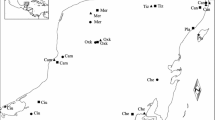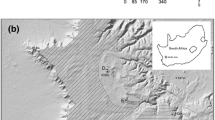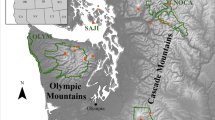Abstract
Patterns of genetic structure for some bee species suggest that gene flow may be limited across natural and human-created barriers and that local dispersal or natal site fidelity may be common. Interestingly, this past work has primarily focused on female bees, despite the fact that males may differ substantially in their dispersal processes. By examining genetic structure and diploidy in males, it is possible to gain insight into potential barriers to gene flow and drivers of inbreeding. In this study, we examine diploidy as well as regional and local spatial genetic structure using males of Bombus vosnesenskii, a stable bumble bee species found across western North America. Specifically, we investigate patterns of genetic structure in both island and mainland populations, across spatial scales, and over a range of natural and human-altered habitats. We document high levels of male diploidy, with significantly higher levels in mainland populations compared to island populations and increasing diploidy in areas with poor nesting habitat. Interestingly, we also find evidence of significant spatial genetic structure from 0 to 10 km and 0 to 5 km on island and mainland populations, respectively. Finally, we document low but significant genetic differentiation across the region (ΦST = 0.049). Overall, this work reveals the unique potential for biogeographic context and local habitat composition to drive male diploidy patterns in bumble bees.


Similar content being viewed by others
References
Babak N (2013) usdm: Uncertainty analysis for species distribution models R package version 11-12. http://www.CRANR-projectorg/package=usdm
Bartomeus I, Ascher JS, Gibbs J, Danforth BN, Wagner DL, Hedtke SM, Winfree R (2013) Historical changes in northeastern US bee pollinators related to shared ecological traits. Proc Natl Acad Sci 110:4656–4660
Cameron SA, Lozier JD, Strange JP, Koch JB, Cordes N, Solter LF, Griswold TL (2011) Patterns of widespread decline in North American bumble bees. Proc Natl Acad Sci 108:662–667
Cook JM, Crozier RH (1995) Sex determination and population biology in the hymenoptera. Trends Ecol Evol 10:281–286
Darvill B, Ellis JS, Lye GC, Goulson D (2006) Population structure and inbreeding in a rare and declining bumble bee, Bombus muscorum (Hymenoptera: Apidae). Mol Ecol 15:601–611
Darvill B, O’Connor S, Lye GC, Waters J, Lepais O, Goulson D (2010) Cryptic differences in dispersal lead to differential sensitivity to habitat fragmentation in two bumblebee species. Mol Ecol 19:53–63
Darvill B, Lepais O, Woodall LC, Goulson D (2012) Triploid bumble bees indicate a direct cost of inbreeding in fragmented populations: direct cost of inbreeding in bumblebees. Mol Ecol 21:3988–3995
Davis ES, Murray TE, Fitzpatrick U, Brown MJF, Paxton RJ (2010) Landscape effects on extremely fragmented populations of a rare solitary bee, Colletes floralis. Mol Ecol 19:4922–4935
Dogterom MH, Matteoni JA, Plowright RC (1998) Pollination of greenhouse tomatoes by the North American Bombus vosnesenskii (Hymenoptera: Apidae). J Econ Entomol 91:71–75
Duchateau MJ, Hoshiba H, Velthuis HHW (1994) Diploid males in the bumble bee Bombus terrestris: sex determination, sex alleles and variability. Entomol Exp Appl 71:263–269
Estoup A, Scholl A, Pouvreau A, Solignac M (1995) Monoandry and polyandry in bumble bees (Hymenoptera; Bombinae) as evidenced by highly variable microsatellites. Mol Ecol 4:89–93
Gallai N, Salles JM, Settele J, Vaissière BE (2009) Economic valuation of the vulnerability of world agriculture confronted with pollinator decline. Ecol Econ 68:810–821
Giangarelli DC, Freiria GA, Ferreira DG, Aguiar WM, Penha RES, Alves AN, Sofia SH (2015) Orchid bees: a new assessment on the rarity of diploid males in populations of this group of Neotropical pollinators. Apidologie 46:606–617
Goslee SC, Urban DL (2007) The ecodist package for dissimilarity-based analysis of ecological data. J Stat Softw 22:1–19
Goulson D, Lye GC, Darvill B (2008) Decline and conservation of bumble bees. Annu Rev Entomol 53:191–208
Goulson D, Lepais O, O’Connor S, Osborne JL, Sanderson RA, Cussans J, Darvill B (2010) Effects of land use at a landscape scale on bumblebee nest density and survival. J Appl Ecol 47:1207–1215
Goulson D, Kaden JC, Lepais O, Lye GC, Darvill B (2011) Population structure, dispersal and colonization history of the garden bumble bee Bombus hortorum in the Western Isles of Scotland. Conserv Genet 12:867–879
Goulson D, Nicholls E, Botias C, Rotheray EL (2015) Bee declines driven by combined stress from parasites, pesticides, and lack of flowers. Science 347:1435–1439
Greenleaf SS, Williams NM, Winfree R, Kremen C (2007) Bee foraging ranges and their relationship to body size. Oecologia 153(3):589–596
Hardy OJ, Vekemans X (2002) SPAGeDi: a versatile computer program to analyse spatial genetic structure at the individual or population levels
Holsinger KE, Weir BS (2009) Genetics in geographically structured populations: defining, estimating and interpreting FST. Nat Rev Genet 10:639–650
Jaffe R, Castilla A, Pope N, Imperatriz-Fonseca VL, Metzger JP, Arias MC, Jha S (2016) Landscape genetics of a tropical rescue pollinator. Conserv Genet 17(2):267–278
Jenkins DG, Carey M, Czerniewska J, Fletcher J, Hether T, Jones A (2010) A meta-analysis of isolation by distance: relic or reference standard for landscape genetics? Ecography 33:315–320
Jha S (2015) Contemporary human-altered landscapes and oceanic barriers reduce bumble bee gene flow. Mol Ecol 24:993–1006
Jha S, Kremen C (2013) Urban land use limits regional bumble bee gene flow. Mol Ecol 22:2483–2495
Jones OR, Wang J (2010) COLONY: a program for parentage and sibship inference from multilocus genotype data. Mol Ecol Resour 10:551–555
Kimura M, Crow J (1964) The number of alleles maintained in a finite population. Genetics 49:725–738
Klein AM, Vaissière BE, Cane JH, Steffan-Dewenter I, Cunningham SA, Kremen C, Tscharntke T (2007) Importance of pollinators in changing landscapes for world crops. Proc R Soc Lond B 274:303–313
Kraus FB, Wolf S, Moritz RFA (2009) Male flight distance and population substructure in the bumble bee Bombus terrestris. J Anim Ecol 78:247–252
Kremen C, Williams NM, Thorp RW (2002) Crop pollination from native bees at risk from agricultural intensification. Proc Natl Acad Sci 99:16812–16816
Kukuk PF, May B (1990) Diploid males in a primitively eusocial bee, Lasioglossum (Dialictus) zephyrum (Hymenoptera: Halictidae). Evolution 44:1522
Larsen TH, Williams N, Kremen C (2005) Extinction order and altered community structure rapidly disrupt ecosystem functioning. Ecol Lett 8:538–547
Lepais O, Darvill B, O’Connor S, Osborne JL, Sanderson RA, Cussans J, Goulson D (2010) Estimation of bumblebee queen dispersal distances using sibship reconstruction method. Mol Ecol 19:819–831
Loiselle BA, Sork VL, Nason J, Graham C (1995) Spatial genetic structure of a tropical understory shrub, Psychotria officinalis (Rubiaceae). Am J Bot 82:1420–1425
Lopez-Uribe MM, Morreale SJ, Santiago CK, Danforth BN (2015) Nest suitability, fine-scale population structure and male-mediated dispersal of a solitary ground nesting bee in an urban landscape. PLoS ONE 10:20
Lozier JD, Cameron SA (2009) Comparative genetic analyses of historical and contemporary collections highlight contrasting demographic histories for the bumble bees and . in Illinois. Mol Ecol 18(9):1875–1886
Lozier JD, Strange JP, Stewart IJ, Cameron SA (2011) Patterns of range-wide genetic variation in six North American bumble bee (Apidae: Bombus) species: Population genetics of North American Bombus. Mol Ecol 20:4870–4888
Mazerolle MJ (2015) AICcmodavg: Model selection and multimodel inference based on (Q)AIC(c) R package version 20-3. http://www.CRANR-projectorg/package=AICcmodavg
McRae BH (2006) Isolation by resistance. Evolution 60:1551–1561
Memmott J, Waser NM, Price MV (2004) Tolerance of pollination networks to species extinctions. Proc R Soc B 271:2605–2611
Ollerton J, Winfree R, Tarrant S (2011) How many flowering plants are pollinated by animals? Oikos 120:321–326
Owen RE, Packer L (1994) Estimation of the proportion of diploid males in populations of hymenoptera. Heredity 72:219–227
Packer L, Owen R (2001) Population genetic aspects of pollinator decline. Conserv Ecol 5:4
Peakall R, Smouse PE (2006) Genalex 6: genetic analysis in Excel Population genetic software for teaching and research. Mol Ecol Notes 6:288–295
Roubik DW, Weight LA, Bonilla MA (1996) Population genetics, diploid males, and limits to social evolution of eugolossine bees. Evolution 50:931–935
Smith BH (1983) Recognition of female kin by male bees through olfactory signals. Proc Natl Acad Sci USA 80:4551–4553
Souza RO, Del Lama MA, Cervini M, Mortari N, Eltz T, Zimmermann Y, Paxton RJ (2010) Conservation of genetics of Neotropical pollinators revisited: microsatellite analysis suggests that diploid males are rare in orchid bees. Evolution 64:3318–3326
Stevens V, Whitmee S, Le Galliard JF, Clobert J, Böhning-Gaese K, Bonte D, Brändle M, Dehling D, Hof C, Trochet A, Baguette M (2014) A comparative analysis of dispersal syndromes in terrestrial and semi-terrestrial animals. Ecol Lett 17:1039–1052
Stolle E, Rohde M, Vautrin D, Solignac M, Schmid-Hempel P, Schmid-Hempel R, Moritz RFA (2009) Novel microsatellite DNA loci for Bombus terrestris (Linnaeus, 1758). Mol Ecol Resour 9:1345–1352
Suni SS, Brosi BJ (2012) Population genetics of orchid bees in a fragmented tropical landscape. Conserv Genet 13:323–332
Thorp RW, Horning DSJ, Dunning LL (1983) Bumble bees and cuckoo bumble bees of California. Bull Calif Insect Surv 23:1–79
Truett GE, Heeger P, Mynatt RL, Truett AA, Walker JA, Warman ML (2000) Preparation of PCR-quality mouse genomic DNA with hot sodium hydroxide and tris (HotSHOT). Biotechniques 29(52):54
Whidden TL, Owen RE (2011) Frequencies of diploid males in natural populations of three North American bumble bee (Bombus) Species (Hymenoptera: Apidae). Ann Entomol Soc Am 104:83–87
Whitehorn PR, Tinsley MC, Brown MJ, Darvill B, Goulson D (2009) Impacts of inbreeding on bumble bee colony fitness under field conditions. BMC Evol Biol 9:152
Williams PH (1982) The distribution and decline of British bumble bees (Bombus Latr). J Apic Res 21:236–245
Williams PH, Osborne JL (2009) Bumblebee vulnerability and conservation world-wide. Apidologie 40:367–387
Wolf S, Toev T, Moritz RLV, Moritz RFA (2012) Spatial and temporal dynamics of the male effective population size in bumble bees (Hymenoptera: Apidae). Popul Ecol 54:115–124
Wright S (1943) Isolation by Distance. Genetics 28:114–138
Zayed A, Packer L (2001) High levels of diploid male production in a primitively eusocial bee (Hymenoptera: Halictidae). Heredity 87:631–636
Zayed A, Roubik DW, Packer L (2004) Use of diploid male frequency data as an indicator of pollinator decline. Proc R Soc Lond B 271:S9–S12
Acknowledgements
We thank Amber Sciligo and Rebecca Ruppel for help in the laboratory and field. This work was partially supported by the National Geographic Society, the National Science Foundation, and the Winkler Family Foundation.
Author information
Authors and Affiliations
Corresponding author
Electronic supplementary material
Below is the link to the electronic supplementary material.
Rights and permissions
About this article
Cite this article
Schenau, E., Jha, S. High levels of male diploidy but low levels of genetic structure characterize Bombus vosnesenskii populations across the Western US. Conserv Genet 18, 597–605 (2017). https://doi.org/10.1007/s10592-016-0900-z
Received:
Accepted:
Published:
Issue Date:
DOI: https://doi.org/10.1007/s10592-016-0900-z




